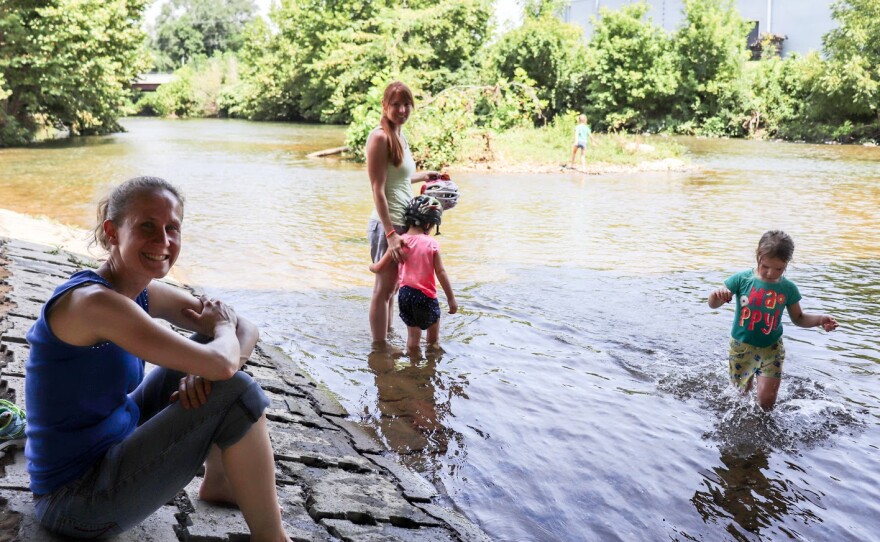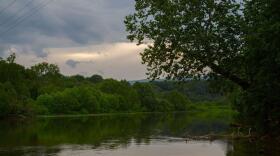Last year DuPont agreed to pay about $50 million to fund projects restoring natural habitat around the South River in Waynesboro. The projects address contamination caused by mercury released into the soil, and the river, by DuPont for decades. WMRA’s Christopher Clymer Kurtz takes a look at the early stages of restoration.
It’s a sunny afternoon in Waynesboro’s Constitution Park, just downstream from the factory where from 1929 to 1950 DuPont used mercury in manufacturing, and released mercury into the South River. For years the Environmental Protection Agency and Virginia Department of Environmental Quality have been involved in ongoing remediation of mercury contamination along the river.
WILLS KITCHEN: Look at him, he was following my lure there.
Today, school district database administrator Wills Kitchen is spending his lunch break catch-and-release fishing here.
KITCHEN: Even for the river being a little bit dirty, there’s a great crawfish population, and crawfish generally will not live in water that is overly dirty. It’s usually a pretty good indication that the river is not in too bad a shape.
Under a nearby bridge, Karen Brookshire and a friend have brought their kids to play in the water.
KAREN BROOKSHIRE: We don’t eat anything out of it because of the mercury. But the kids, we don’t worry about kids playing in it. It’s a little gross, but it’s not because of the mercury.
A bit further upstream, closer to the former DuPont factory, Waynesboro Mayor Terry Short describes a completed remediation project aimed at reducing the reintroduction of mercury into the river.
TERRY QUOTE: This entire bank was excavated and the mercury-contaminated soil was removed, hauled off to an eligible landfill someplace near the east, and backfilled with dirt, covered with biochar, new soil, and then new plantings, and so the entire bank that you see here that stretches all the way down almost to the foot of the pipes, that was all replaced. This has all been replaced.
But efforts to remove mercury from the natural environment can do only so much. According to a report from the U.S. Fish and Wildlife Service and Virginia, [quote] “remedial efforts are not likely to remove all mercury from the system.”
That’s where the settlement announced last year comes into play.
ANNE CONDON: We’re not actually providing any funds to clean up at all. We’re mostly just trying to figure out what was injured and replace that injury in some way.
One trustee of the settlement funds is the Commonwealth of Virginia, represented by the state Department of Environmental Quality. The other trustee is the U.S. Department of the Interior, represented by the U.S. Fish and Wildlife Service, represented here by Anne Condon.
CONDON: We’re trying to do land protection and habitat restoration, projects that will improve water quality and fish habitat, projects that will improve recreational fishing opportunities, and different things that will benefit migratory birds and other wildlife, that were impacted.
Condon said that the settlement includes a fish hatchery renovation project in Front Royal, still in the design phase, which will cost an estimated $10 million, plus approximately $42 million for natural resource restoration projects.
About 75% of those restoration funds have been allocated for projects through partner organizations such as the City of Waynesboro, the Alliance for the Chesapeake Bay and Soil and Water Conservation Districts. Some include the acquisition of 2,400 acres of land, removing the invasive wavyleaf grass in Elkton and the Shenandoah National Park, and implementing “best management practices” for agriculture such as fencing to keep farm animals out of streams.
The trustees plan to accept more proposals, including to benefit migratory songbirds.
CONDON: We don’t have a ton of progress to report right now because we’re really just beginning, but we’re expecting a lot of movement forward in the next year or so with all these projects.
The money isn’t necessarily being spent on directly contaminated areas.
CONDON: Because there’s still mercury in the system, we’re focused more broadly on improving that watershed in general, so the projects are kind of scattered throughout the watershed.
At Constitution Park, Mayor Short describes part of what he hopes will become a reality using settlement funds:
SHORT: Where we’re standing here, we’ve kind of envisioned a series of grove, meadows, potentially water ponds, where we can attract potentially more songbirds. It’ll be a really neat resource for school systems to send their children down here, learn about the remarkable sort of songbird habitat that Waynesboro enjoys, learn about the waterways, learn about mercury, and the importance of clean water, and how water is life.
Short knows the mercury from the nearby former DuPont factory will long outlast him.
SHORT: You know, it’s like anything else in life: You try to commit a little bit of improvement with the expectation and hope that long-term your community will realize a long-term and lasting benefit and improvement from it.







